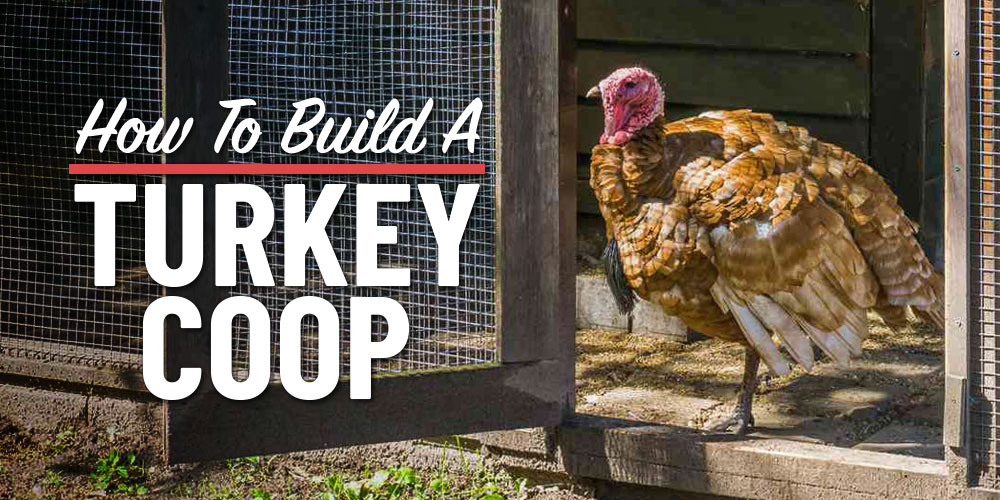
NAVIGATION
If you’re considering adding new poultry, such as turkeys, to your homestead, it’s a great way to diversify what you produce on your homestead farm. But before you bring those turkey poults home, you’ll need to have a turkey coop. Turkeys need suitable habitats to flourish, and learning how to build a turkey coop will help you protect the turkeys and ensure you don’t lose the time, money, or care you’ve invested.

Hi, I’m Ryan
I’d been homesteading a few years before I considered adding turkeys to my farm. At first, I thought it would be the same as raising chickens, but I quickly learned that turkeys involve more care and patience than chickens. With the turkey coup I built, my birds are happy in their home and don’t feel the need to roam.

Do Turkeys Even Need A Turkey Coop?

The short answer is yes, and I’ll show you step-by-step how to build a turkey coop to keep your turkeys healthy and safe.
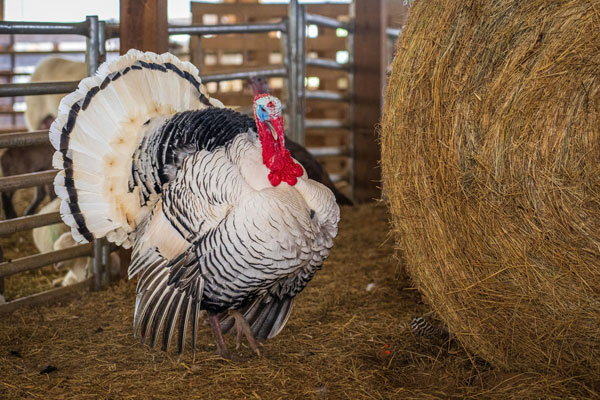 You might think they’ll spend little time in the coop, but having a place to keep your turkeys protected and sheltered is essential. In fact, there are a few reasons why it’s good to have a turkey coop, but keeping them safe is the main one. Whether the threats come from predators or extreme weather, giving them the option of shelter will keep your birds content and protected.
You might think they’ll spend little time in the coop, but having a place to keep your turkeys protected and sheltered is essential. In fact, there are a few reasons why it’s good to have a turkey coop, but keeping them safe is the main one. Whether the threats come from predators or extreme weather, giving them the option of shelter will keep your birds content and protected.
A turkey coop becomes especially important if you are raising turkeys from infancy. Turkey poults must be sheltered for the first several weeks of life. The primary concerns in this phase are keeping the young poults out of harm’s way and protected from the elements in a controlled environment.
Requirements for Raising Turkeys

There are some requirements for raising healthy, happy turkeys that you’ll want to keep in mind from the go. First, you want to choose the turkey breed that best fits your space and meets your goals for raising turkeys. Once that’s decided, raising turkeys is fundamentally similar to raising chickens or other birds. They’re both raised by many homesteaders as versatile protein sources in a slow food diet. The key differences are that turkeys can become quite sizable and are capable of flight, leading to them wanting to roost in higher locations.
When planning your homestead layout, keep in mind that turkeys require more land than other poultry. Adult turkeys need space to move about and eat grass, which is the bulk of their diet, and sufficient space to roost at night. You’ll also need room for nesting boxes and a dedicated area to isolate baby turkeys.
How Much Space Does A Turkey Need In A Turkey Coop?
Use this guideline to determine how much space you need per turkey:
- 0–10 weeks = 2–3 square feet per turkey
- 10–20 weeks = 3–8 square feet per turkey
- 20+ weeks = 8–10 square feet per turkey
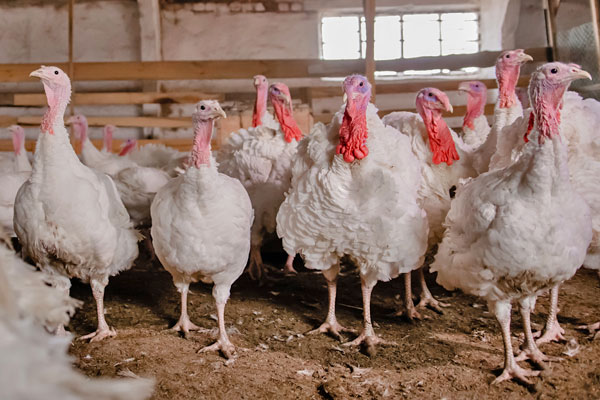
What Type Of Flooring Is Needed For A Turkey Coop?
The most basic floor of a turkey coop is an earthen floor. What you put on the earthen floor may vary based on your birds and their life phase. Some turkeys appreciate a bed of hay or straw while nesting with poults, but many turkeys prefer clean wood shavings of a softer wood, like pine, when they’re not tending baby turkeys. With adult turkeys, I like to switch it up and sometimes use sand as flooring since it’s inexpensive and easy to clean.
Turkey Nesting Boxes
To encourage reproducing, you’ll need to provide turkeys with nesting boxes that make a comfortable space for laying their eggs, which a hen will do night and day for 28 days until all of the eggs hatch together. A nesting box doesn’t need to be large or fancy — it can be a simple wooden cube with an open face for entry, about two feet on all sides.
Having A Turkey Roosting Area In Your Turkey Coop
A turkey roosting area is one of the primary ways building a turkey coop will vary from building a chicken coop. To create a roosting area that your turkeys will want to return to each night, you need some height — 3–4 feet will satisfy most birds. Remember that these are animals ruled by instinct, which tells them to roost in trees. Everyone will be happy if you can provide something tree-like while keeping your birds safe from harm.
Food And Water Access In A Turkey Coop
Feeding and watering your turkeys is not so different than tending other birds. Turkeys are hardy and can live outside nearly their entire lives, starting after they reach eight weeks of age.
If you live in a particularly wet climate or experience a rainy season each year, you may want to situate turkey feed, especially for the poults, inside the coop or at least under a cover. Access to fresh water is the other central element in turkey health.
Turkeys drink more water than other birds — I was surprised when I saw how quickly they went through it — and they prefer cold water. You may use either a barrel-style waterer or a nipple-style waterer while the turkeys are brooding.
Predator-Proofing Your Turkey Coop
Your main goal in raising turkeys is to keep them healthy, strong, and safe. You’ll lose all the effort you put into your birds if predators like coyotes and raccoons get to them, and you don’t want your turkey flock to get injured or suffer needlessly. My neighbor uses an electronic, programmable door on their turkey coop that opens in the morning and closes at night.
Turkey Coop Ideas

Turkey coops can be made from a variety of materials, and you might even have some on hand already on your homestead. Your turkey coop can be built from wood, metal, or wire and can be a miniature house, shed, or any framework with a roof. Here are some ideas.
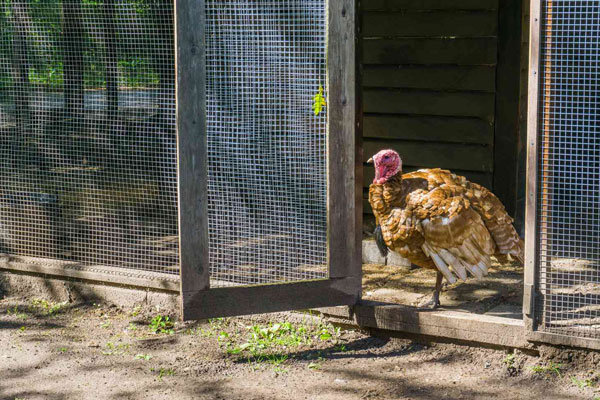
I have a friend whose turkeys wanted to sleep on the roof of their coop almost every night! Building a turkey coop the birds actually look forward to roosting in will help you protect your flock.
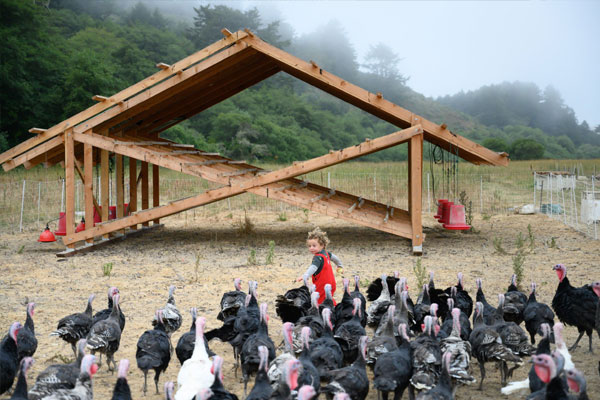
How To Build A DIY Turkey Coop, Step-by-Step

If you’re homesteading on a budget, you can control cost by using scrap wood for the construction. My neighbor was able to build a turkey coop from diseased trees that had to be cut down but still offered a large quantity of usable lumber. This mindset is the one to adopt if you’re homesteading to save money.
Step One: Decide On The Location And Design
The size will depend on your available space and the size of your flock. It’s possible to turn “difficult” land for growing, like a slope, into an area for birds, like I did with my chicken coop. Two square feet per turkey is a good rule of thumb, so 40 square feet would be sufficient for 20 grown birds. Some coops are house-like, with entire walls; others are more of a framework, open to the air, and conducive to these birds’ desire to roam their environment.
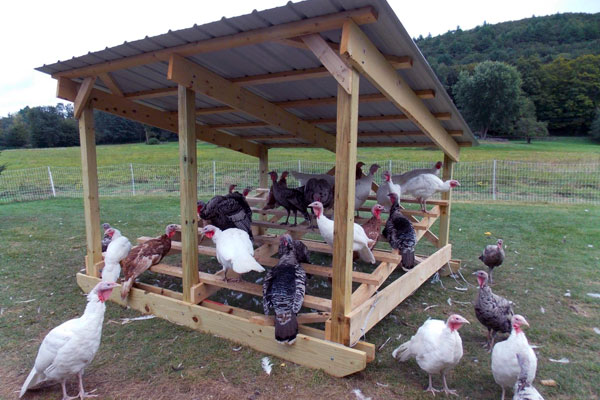
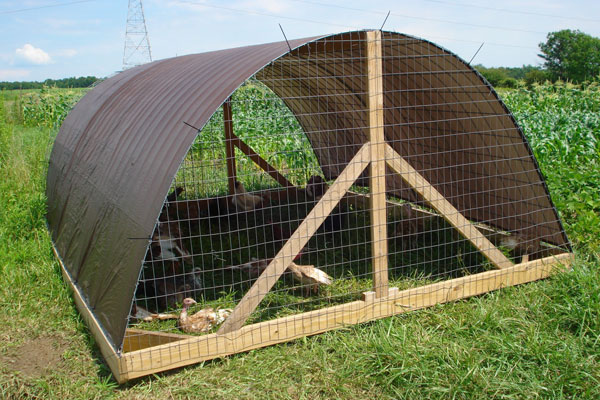
You will also want to be sure that your coop is not far from a water source to replenish the many gallons these birds will go through each day. If you’re using electronics such as a coop door or heat lamp, situating the coop near your utilities is essential, but many find a low-tech setup suitable.
Step Two: Source Your Materials
While most coops are constructed from wood, the roof may be shingled, metal, or fiberglass. The style you choose depends on the predators in your area, as well as your climate and the need to either let air flow for ventilation or keep warm air in during cold seasons. Some people harvest their turkeys every fall and do not need to house the birds over the winter.
For my 8 ft. by 5 ft. turkey coop, housing about 20 birds, I used:
- 40 2x4s to build the basic framework.
- Two metal sheets to form a V-shaped roof.
- A few rolls of thin mesh to build walls.
- A fence supported by wooden posts.
- 4’ high chicken wire attached to fence posts.

I live in a pretty temperate climate in the Carolinas, and the birds are happy in their coop most of the year. When they have continuous access to food, turkeys have no issue amassing enough body fat to survive the winter. In more northern areas, you may want to add heat lamps. A source of heat during the cold season can also stimulate egg production in older birds.
Step Three: Consider Creature Comforts
You can either build a single coop with different roosts on various corners or a set of adjoining coops. I even used a hay bale when I was still setting up my coop, giving the turkeys another option to get off the ground.
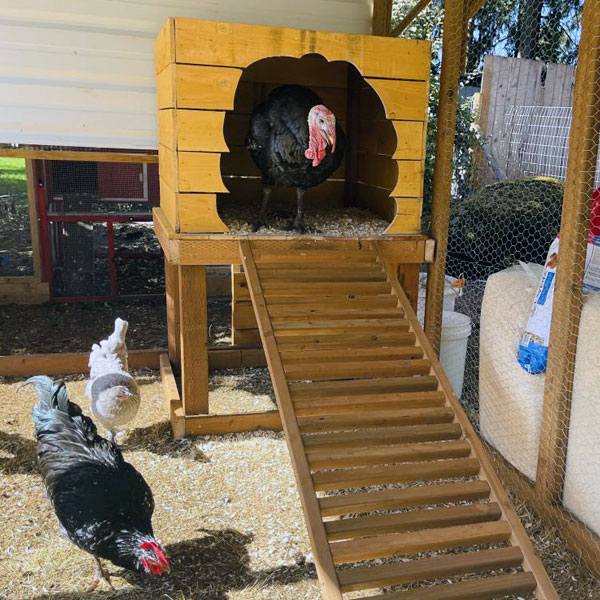
I’ve used branches for the bars since my homestead is in a wooded area, but I know some people use 2x4s. Depending on whether you are housing heritage or broad-breasted birds, you will want to allot 12 to -15 inches of space for each turkey.
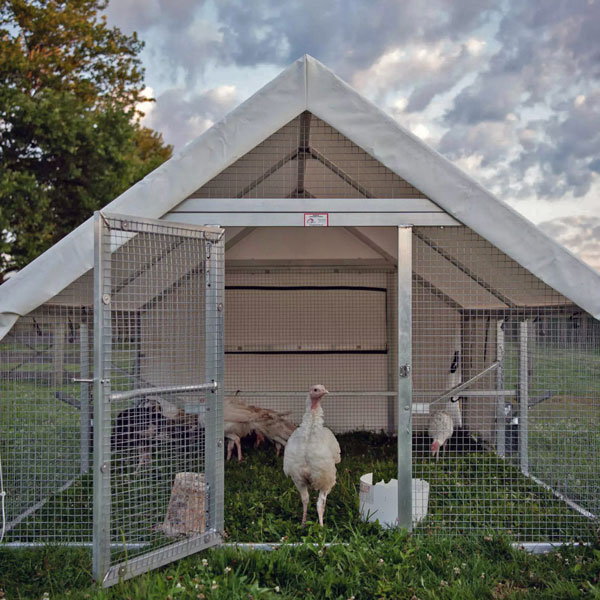
FAQs About Building Turkey Coops

Here are some of the most frequently asked questions I get about how to build a turkey coop and raising turkeys on the homestead or backyard.
Do My Turkeys Need A Perch?
Yes, many turkeys will vary their free ranging with down time in the coop. Creating a roosting bar to accommodate their perching is a key element of turkey coops. You’ll want a long bar to accommodate several birds at a time — I have mine running along the entire length of the coop, in three tiers, similar to a wide ladder.
Can You Keep Turkeys And Chickens In The Same Coop?
It is possible to keep chickens and turkeys together in the same coop. However, whether turkeys and chickens can live happily together depends on a few things. First of all, you’ll want to be sure you have the accommodations mentioned above for each bird type, including appropriate-sized roosting bars, which for turkeys means thick enough for their larger feet and higher places to roost.
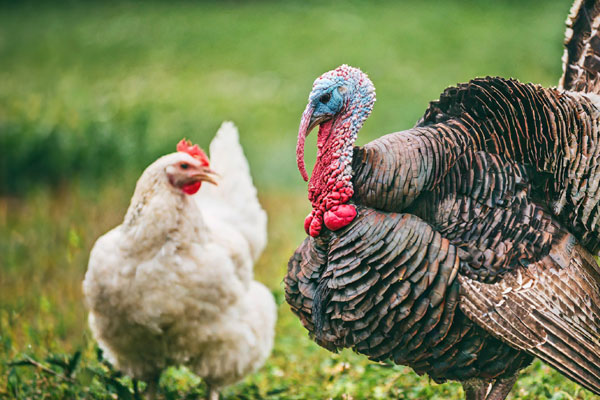 However, remember that the hatchlings of chickens and turkeys differ enough that keeping them apart, at least in the earliest weeks, is important. Chicks tend to be feistier and more aggressive than poults, which can cause problems. The diets of these young birds also differ slightly, which is another reason to keep the groups apart.
However, remember that the hatchlings of chickens and turkeys differ enough that keeping them apart, at least in the earliest weeks, is important. Chicks tend to be feistier and more aggressive than poults, which can cause problems. The diets of these young birds also differ slightly, which is another reason to keep the groups apart.
Once grown, these aspects are less of a concern, but if disease strikes either group of birds, you’ll want to keep them in separate quarters. At the end of the day, I recommend keeping them in separate coops to allow them to thrive in their own environments.
Will Free Range Turkeys Fly Away?
Wild turkeys can fly in short bursts, but the wings of domesticated turkeys are underdeveloped, making it hard for them to get off the ground. We are used to seeing them on the ground, searching for food, but their instinct is to roost in the tops of trees at night. Many farmers clip the wings of domesticated turkeys as an added precaution to ensure they don’t go astray. Others cover the turkey run with wire to keep them in the coop. I’ve found that a fence around the ranging area at least 4 feet tall meets my enclosure needs, deterring flight and keeping them safe from predators.
Do Turkeys Need Roosts?
Keeping in mind that their instinct is to fly, providing a roost for your turkeys to return to at night is a great way to keep the birds happy and less eager to roam. For that reason, you want to build some elevated roosting spots in your coop — such as shelves attached to the walls — for the turkeys to roost on comfortably. Be sure to build the coops uniformly, or else the turkeys will fight each other for what they perceive as the “best” roosting position.
Do Turkeys Return To The Coop At Night?
Turkeys will return to their coop at night when you make it attractive to them, like by offering the roosting bars that give them the feeling of sleeping in a tree. So it really boils down to building a turkey coop that’s spacious enough to house the turkeys comfortably and meets their instinctual need to roost.
How Do You House Turkey Poults?
Raising turkey poults is a rewarding experience. Building a coop to house those turkey poults is a key part of the process. A hen sits on her eggs for 28 days before all the eggs hatch at once. Upon hatching, the poults look to their mother for direction, keeping close and nesting under her feathers for the first few weeks of life. Since their mother warms them, a warming light is often unnecessary, especially in milder climates where overheating is a risk. A special feed for baby turkeys will also help them grow strong.
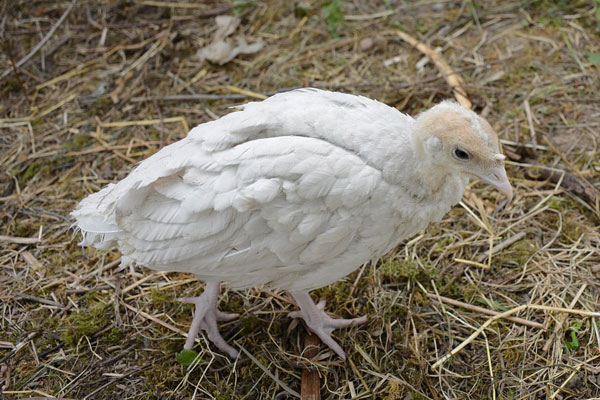 Keeping these active young birds safe and protected in a turkey coop from day one is a key element to ensuring that all your hatchlings get a fair chance. Once you have your breeding turkeys under control, you may want to branch out to other types of poultry.
Keeping these active young birds safe and protected in a turkey coop from day one is a key element to ensuring that all your hatchlings get a fair chance. Once you have your breeding turkeys under control, you may want to branch out to other types of poultry.
Learning how to build a turkey coop was a necessary skill I developed once I decided to raise turkeys on my homestead. Homesteading might seem simple initially, but it keeps me busy, and I learn new things daily. Remember that while turkeys are wild animals, they’re not highly complex. Given adequate food, water, and space, they’re often happy enough on a homestead farm that they feel no need to roam beyond their run. The tips above will help keep your flock content, safe, and thriving.
Your Turn!
- Will you be raising turkey poults or buying turkeys that have already matured?
- How many turkeys do you plan to raise, and how many square feet will you need for them?




Leave a Reply